I Kickstarted a card game and decided to use Amazon to handle my fulfillment. Why’d I do it? What problems did I run in to? Would it work for you?
Part 2: Accurately Estimating the Shipping and Fulfillment Costs of Your Kickstarter Project
“Accurately Estimating” is an oxymoron. Not pursuing an accurate estimation of your shipping costs is moronic. You see – everything is connected.
Estimating the cost of shipping your product is annoying, obscene, and generally swept under the rug. Some would say it’s the number one thing that Kickstarter creators screw up and lose a bunch of money on.
After funding my Kickstarter, I mapped out all of my shipping options and costs on my whiteboard at home. Note that I said “after my Kickstarter.” Don’t be like me.
Since then, I have successfully shipped my games to each of my backers and have gained a much better understanding on how much things cost. In this article, I am going to help you draw out your own cost map and it will be much simpler than mine.
Step 1: Two Starting Points
I’m going to cover two options for fulfillment in this blog post: DIY (shipping from your house) vs Amazon Multi-Channel Fulfillment (shipping from the Amazon warehouse). I haven’t worked with any other 3rd party fulfillment centers and while some of these factors may align, I cannot speak for certain about the various costs and fees of those other services.
I am not going to include the cost of getting the games from your manufacturer to you or to Amazon. Later, make sure to get quotes from your manufacturer to see if there is a difference in shipping from one location to the other. For me, the cost was the same.
Step 2: Calculate the cost to ship one of your items
First things first, get the weight and dimensions of your product – or at least a good guess. Here are my game’s measurements:
Shipping Items Yourself
Let’s narrow down which packaging will work best for you. We will first check out flat-rate USPS boxes and then custom-sized boxes.
USPS Flat-Rate Shipping
In short, flat-rate means that neither your product’s weight nor where you ship it matters; the price will not change. Here’s the selection of USPS flat-rate boxes:
The above dimensions are the inner dimensions, so you can accurately tell if your product fits in the box. (Outer dimensions are 1/8th of an inch longer, just so you know).
Figure out the smallest one that your item fits into and then record the corresponding prices for domestic and international shipping.
For the game makers reading this, it is actually a “thing” to size your game box to fit into one of the above boxes. I’ve seen a number of smart Kickstarter creators size their game to fit right into the small USPS flat-rate box to ensure a great shipping rate. (For example, Slash and Boss Monster)
Additionally, the actual cardboard boxes for these are FREE. You can just pick them up from the Post Office. However, consider this poem.
To avoid stern sighs | and emptying your post office’s supplies | order boxes from the USPS site | which is also free.
Custom-Sized Shipping
Here’s a link to ULINE, a website that specializes in custom box sizes. Scroll towards the bottom of this page to where you can ‘search by size.’ Find a box that fits the size of your product the best.
Record the per-box cost of, say, 500 boxes. It was about .35 cents per box for me.
You may be wondering why I made you do that extra work for such a small cost. One, because every dollar counts and two, to make sure you know how easy it is to order custom-sized boxes. I shipped out around 30 of my games in ~$12 flat rate boxes before I realized that it would cost much less to ship in custom-sized boxes.
Now check this USPS site to calculate shipping for your package. To get a nice estimate, you’ll want to check two zip codes: the first one should be very close to you and the second should be very far. I live in Atlanta, so I chose another Atlanta zip code for my first choice and a California zip code for my second. (In my opinion, you shouldn’t worry about Alaska and Hawaii).
After putting in a destination zip-code and shipping weight (shipping date shouldn’t matter), select ‘Package’ in the second row of shipping choices and then hit ‘Continue’. On the next page, select Priority Mail Options and then look at Priority Mail 2-Day. That should be your cheapest option. I’ve highlighted it below:
Small rant: You’ll notice that there is a ‘Price’ and an ‘Online Price.’ I tried my damnedest to use USPS online shipping. I downloaded tools, tried the online website, but it just wouldn’t work. I think I shipped / printed labels for 5 packages before it would no longer accept my credit card. After researching more, it seems that very many people were having the same issues and they have not been fixed yet. I encourage you to try it yourself as you may have better luck, but for this post I will assume you are not shipping with the USPS online prices.
Average the cost of shipping to both zip codes. Add the ULINE cost-per-box to that price and write it down. Now do all of that again with calculations for shipping your product to Canada, Europe, and Asia.
Having fun yet?
This is just a hint of the work needed to make your Kickstarter campaign successful. It’s all worth it to make your dream come true.
You now have the DIY price for flat-rate shipping vs custom-sized box shipping! Go ahead and circle the one that costs less.
Note: Even if the custom boxes are cheaper, you may still use flat-rate boxes for backers that ordered more than one product from you or had a bunch of add-ons.
Here’s my chart so far:
Now for Amazon
First, I will go over how Amazon classifies your product. Each tier has a different fulfillment price.
To make things confusing, Amazon references many tiers in their documentation. They are various combinations of ‘small, standard, oversized, media, and non-media’. However, for multi-channel fulfillment, only these 3 price tiers are used:
- Standard-Size Media
- Standard-Size Non-Media
- Oversized Media and Non-Media
My first question was “What counts as media?” I really had to know since the prices were so much better. Alas, card games were not included.
This counts as Media:
- Books
- Music
- Video Games
- DVDs
- Software
Next: Sizing. Here’s a chart straight from Amazon that will let you know if your product is Standard-Size or Oversize:

Note: If your product is Oversized you will not be able to use Amazon Multi-Channel Fulfillment for international orders.
You should now know which of the three price tiers your product falls into. Choose the corresponding chart below to complete your per-unit calculation. If you have an Amazon Seller Account, you can view these charts here.
Standard-Size Media
Standard-Size Non-Media
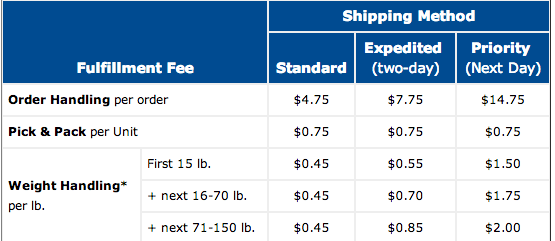
Oversize Media and Non-Media
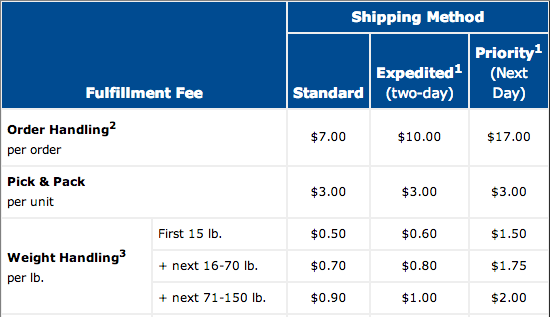
As you can see, there is a basic handling, packing, and weight fee. The weight fee is per pound. Oh yea – unless your backers are really unhappy with how late your project is, you should only pay attention to Standard shipping prices.
Amazon International Fulfillment
International Multi-Channel Fulfillment is actually called FBA Export. And no matter how much it says in the documentation otherwise, you CANNOT use multi-channel fulfillment for your orders unless they are considered media.
I repeat: you cannot use Amazon Multi-Channel Fulfillment for non-media items. It’s a huge bummer. Also, your media item must be standard-size, but that shouldn’t be a problem.
If your product is considered Standard-Size Media (see the chart above), then you can skip ahead. I’m going to quickly cover two alternatives.
1) You can just ship the international items from your house. I sent all of my games to Amazon and then used the cheap ‘return-product’ option to send me all of the games that I needed to ship out of the country. To calculate this, add the .50 per unit fee to the international DIY rates you already calculated above.
2) Read Jamey Stegmaier’s blog on using Amazon to ship items all over the world. It’s great stuff. To summarize, you will ship a big stack of your games to Amazon warehouses on different continents, sign up for Amazon accounts in different countries (Amazon.de and Amazon.co.uk for example), and then pay “domestic” shipping prices for those countries.
It’s hard, but it could save you more money than shipping it from home, especially if you have a decent number of international backers.
So you have Standard-Size Media to ship internationally?
Here is the price table, which you can find here on Amazon.
Alrighty. Calculate your FBA Export prices to various exotic locales and write them down.
You should now have a very good idea of how your DIY and Amazon costs compare. Here’s my final chart, highlighting which option is cheaper for me. Note that I added $.50 to each of my international DIY costs.
This should actually give you a great idea of how much *more* to charge for international shipping. If I had done this ahead of time, I would have added $10 to shipping to Canada and ~$19 to the rest of the world. Instead, I charged a flat $9 international shipping rate. Don’t be like me.
Now for the payoff
Let’s do a quick calculation of what it would cost to ship 100, 500, or 1000 items to backers here in the US. As the numbers get bigger, the savings becomes more apparent.
Keep in mind the above price differences as you read through the next section.
Step 3: More costs, fees, pros, cons, and things to keep in mind
Amazon Fees
1) Monthly storage fee. If you plan to keep your items in an Amazon warehouse after delivering to backers (so that they can continue to fulfill your online orders) you will pay a monthly, per-cubic-foot fee. Amazon actually has a GREAT fee calculator for this. Here’s the screenshot in case you haven’t signed up for your sellers account yet:
For example, my 4 x 4 x 9 game is 0.083 cubic feet or 4 cents a unit each month. All together, I pay roughly $40 a month in storage fees.
2) Long term storage fee. This took me a bit to understand, so I’ll break it down for you. You only pay the long term storage fee if your product is in an Amazon warehouse for a full year. The cost is 22.50 per cubic foot.
Sounds scary, right? My plan is to sell as much as I can in my year and then if I still have a lot of units unsold, I’ll use Amazon’s ultra-cheap 50-cents-per-unit to send them home. Or, I’ll suck it up and pay the roughly $1.80 per unit to keep it in storage.
3) The Amazon move-your-product-around fee. OK, this is a big deal and I feel bad that I haven’t brought this up yet. It’s tough because it might not even matter in the end, but you have to know about it.
Without getting into the details, I’ll say that when you ship your product to Amazon, they will want you to ship it to three separate warehouses. That’s ridiculous and expensive. You can decline this and ship it to just one warehouse, but there is a fee. However, you may never get charged this fee.
It works like this: If people start buying your product in a region that is pretty far away from where your product is stored, Amazon will ship a portion of your products to a warehouse closer to that region to save money on shipping them. If this happens, you will be charged a per-unit fee based on the chart below.
I have not had the blessing of selling enough games for this fee to manifest itself. I’m just getting started though, so who knows?
In any case, this blog post is about Multi-Channel Fulfillment, not what comes afterwards. I fulfilled ~300 games with Amazon and there has been no moving my product around yet.
DIY costs
1) Time. It’s going to take you a while to organize, print, label, pack and ship your products to all of your backers. Do you love your family? No? Ignore this, then.
2) Packaging. You already calculated the per-cardboard-box cost for your product. Now add the cost of packing tape, labels, packing filler (I suggest paper, not peanuts), pens and/or printer ink, and gas money to drive back and forth to Office Depot and the Post Office.
3) Space. Some people don’t mind having 1500 items crowding their garage, guest room, attic, den, or kitchen. Just keep in mind that they might all end up fitting in the fireplace if the person you live with feels differently.
“Roaches love cardboard.” – my fiancee.
Final Calculations
I want to address a special case where you have chosen to use Amazon to fulfill your product, yet one or more of the items you have offered to backers cannot be fulfilled by Amazon. For example: an autographed copy of your item.
What do you do then? I think you should ship your items to Amazon first and then use Amazon’s cheap return-your-product option to send the items you need to your house. I promise it will be way less expensive than shipping from your place to Amazon.
Closing Notes
I have done my best to offer accurate advice and I hope that I have made things much easier for you by compiling my research into this guide. However, you should never trust people on the internet. Please double check my work in regards to your product.
Additionally, the Amazon fulfillment prices change every once and a while, so it may be different by the time you are reading this.
Let me know if I missed something or if you have any questions.
The next blog, Part 3, will explain how to setup your Amazon product online, how to get your product to an Amazon warehouse, and then how to make a fulfillment order.
– Chris
You can follow my gaming Twitter @whatohgame if you are so inclined.
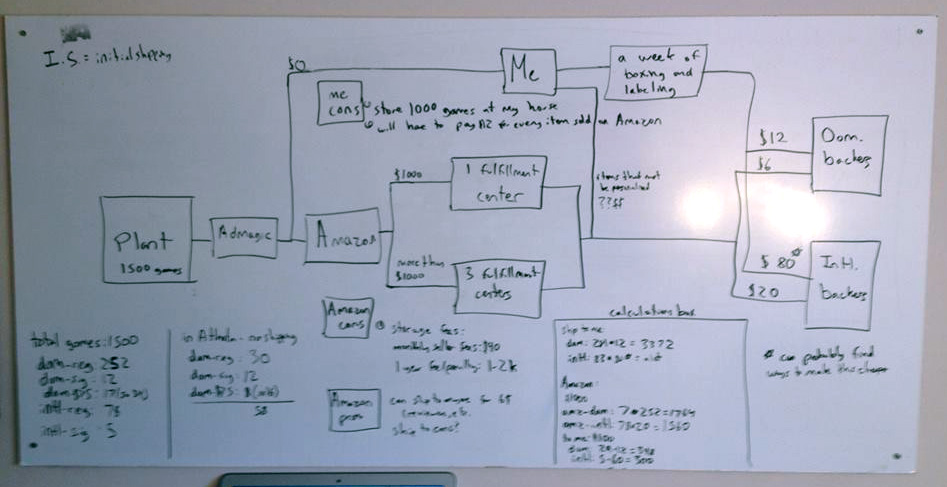
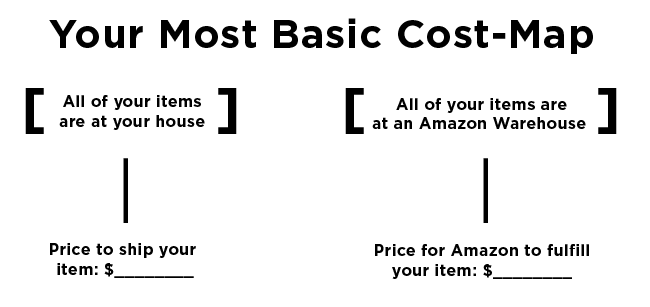
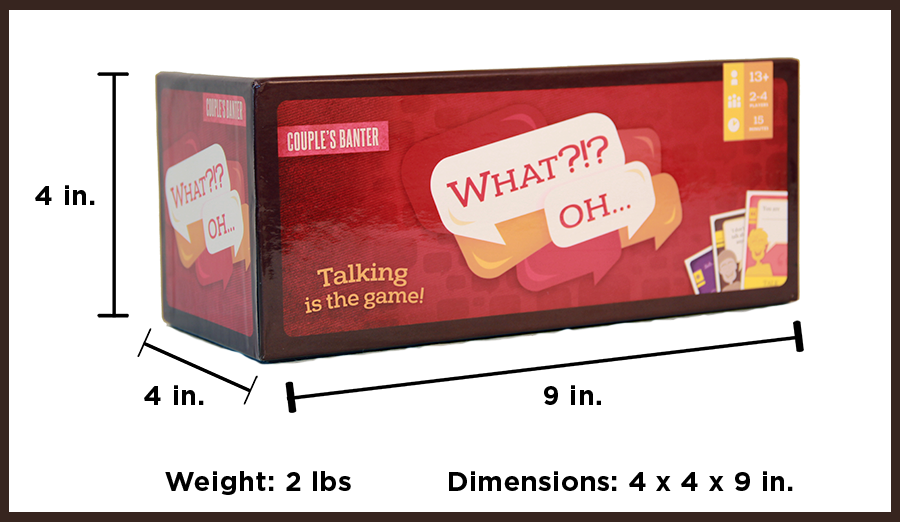

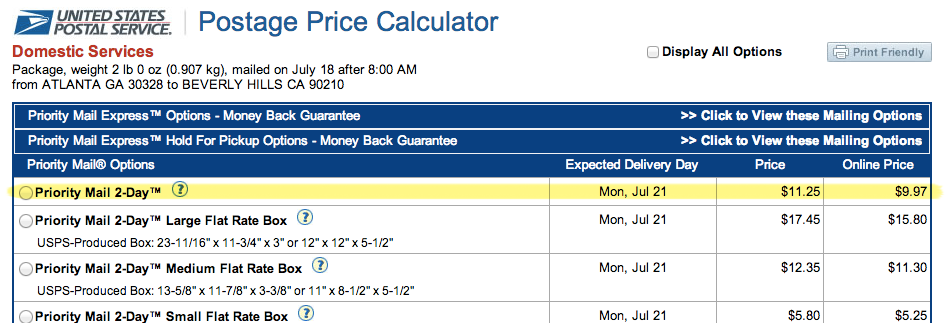
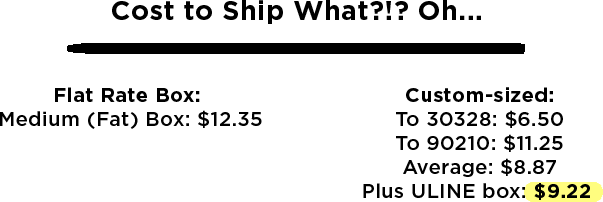
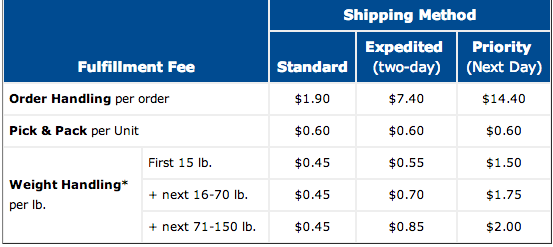

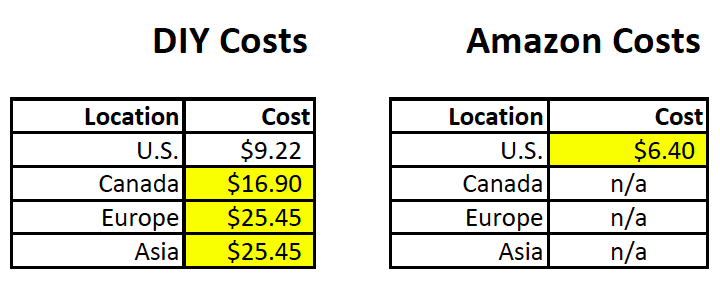
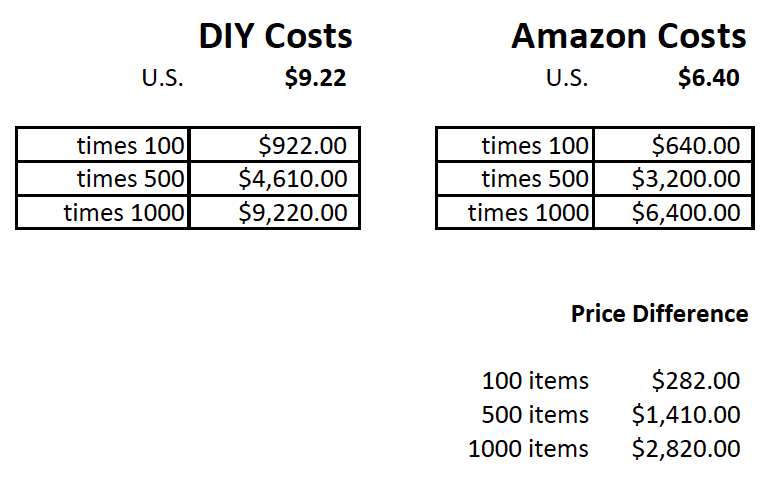


Just a side note:
You can get boxes that will fit into a flat rate padded envelope that runs about $.35,shipping the envelope is around $5.45 I think. If your product can fit this way it comes out just under amazon, but no risk of long try storage.
I appreciate it Ian! What dimensions of a box can you fit within this envelope?
Thanks for another great article!
Thanks! Glad you found your answers about international shipping
Evan! I wanted to let you know that I made a large amendment to the section about using Amazon Multi-Channel fulfillment for international shipping. Turns out it will *only* work for media items, even though the Amazon help docs state otherwise. Very sorry for the confusion.
Hey,
No probs, thanks for the update! Again, great article and looking forward to the next.
Thanks for sharing this information. As always, feel free to link to the posts I’ve already written about this subject if you think that would be helpful for your readers to learn about using international Amazon fulfillment centers and 4px in Asia.
I have a question about the section on international multi-channel fulfillment. Amazon’s website seems to have some contradictory information about that. In one place it says, “Only media products are eligible for Multi-Channel Fulfillment exports.” (as you noted, games are included in the media category). In another, it says, “Through this feature, you can export media (Books, Music, Videos, and DVDs) and eligible non-media products using Priority (2-4 days), Expedited (5-8 days)…”
I’m going to test this out myself, but perhaps you can answer based on your experience: Have you shipped your game internationally using FBA Export?
Just to follow up, I just tried to send a copy of Euphoria from the US to a charity event in Canada via FBA export, and I got the following message: “No items in your order can be fulfilled. Please remove any non-media items from the order.”
Perhaps you found a way around it?
Ah ha – well, that clears it up. Remember in my last comment I said I ‘double confused’ myself and ended up shipping international orders myself? It’s because when I actually got to trying to use FBA export, it didn’t work. That being said, it’s 2 months later that I’m writing this blog and looking at the Amazon site makes it seem very clear that *I should be able to use FBA export for multi-channel fulfillment*. So I assumed it was working again. Really really confusing.
I’m going to test it out myself, reach out to Amazon support if needed, and then amend the blog. Thanks for looking it up yourself. And I’ll definitely link to your blog as it covers using Amazon internationally whereas mine only covers domestic shipping.
Yeah, while poking around on the site, I can see where the confusion came from–there’s contradictory information there. I was excited that maybe something had changed, but as noted above, it didn’t work for Euphoria when I tried a few minutes ago. It’s possible that I don’t have Euphoria correctly classified, so if you find a better way, I’d love to know about it!
Yep, I emailed Seller support just to make sure. They sent back one of the most apologetic letters I have ever received – I’ll have to show it to you some time, he sounded very upset that he couldn’t help! Going to amend the blog now and thanks for checking me on that.
I happened to speak with Amazon yesterday about a different matter, and I brought up the media/non-media situation. I asked them if they anticipate offering international multi-channel fulfillment for non-media items in the future, and the rep said they hope to expand to that in the future, but they don’t have a timeline for it.
I’ll keep my fingers crossed. It would make things very easy for a lot of KS creators.
Hi Chris! I’ve been waiting for the Part 2 of your Amazon fulfillment blog! 🙂 Well, I can say that you’ve done a great job in helping new project creators like me thru this blog. 🙂 I need clarifications on a few things though: 1. Does the USPS international shipping cost that you’ve mentioned above includes tax already (e.g. VAT, customs?) 2. If no, how do you pay these taxes when being delivered to backers(if applicable in certain countries)?
I asked these questions because I’ve experienced paying for customs tax or VAT when I receive orders/deliveries here in the Philippines.
Hope you can enlighten me on this. 🙂
Hey Reich! So glad that these blogs are helpful to you. I should have another one out this weekend about setting up your products on Amazon.
Ok, so for your question about customs – I’m glad you asked, because this was also confusing for me at first. In fact, I may even right a mini-blog post about it.
To answer – no, my calculations did not include customs charges.
The simple answer is that the person who buys the item will pay customs taxes. When I first heard that I was a little freaked out because I didn’t want my backers to have to pay even more money. I was assured that international backers *definitely* know about it ahead of time and generally make their buying decisions with that in mind.
Of note, my game was 25 dollars and a few of my backers let me know that their wasn’t a customs tax on a product that was only worth 25. I would have to research actual customs taxes for different countries, though, to know for sure.
Next, if you read Jamey Stegmaier’s blog (that I reference in the Amazon international shipping section above) about using the international Amazon websites and warehouses (Mine only covers the US) then he will explain that you will have to pay a VAT tax when shipping your games to an Amazon warehouse in another country. If you do that, though, your backers will not pay a customs tax because it would be considered domestic shipping.
If anything I said doesn’t make sense, let me know!
Thank you for the clarifications Chris! Well I’ve read Jamey’s post about international shipping via Amazon warehouses (which is a brilliant way to ship internationally btw) and I think my only problem with that is I do not know anyone from the UK who can serve as our ‘importer of record’. Also, I do not have an idea yet as to how many backers from the UK or Germany will buy our game. As for your game, What Oh, did you have many backers from EU?
Maybe you can let us know if you have confirmed that there will be no customs taxes put on a 25-dollar game/product? 🙂
I didn’t hear from any of my backers that they paid any customs fees. Here is an online duty calculator that may be helpful: http://www.dutycalculator.com/. I just did a test run with a 25.00 game and it said there were no duty or VAT fees with it. So, good news!
As for finding an ‘importer of record’ – I really don’t know. You may have to search and hire someone, or maybe your game manufacturer will know someone.
For me, I had roughly 30 backers from the EU.
Sorry for the late reply, hope it helps!
No problem. Thank you so much for sharing such info, Chris! 🙂
Great series of articles, Chris! Thanks for writing them.
One thing I’m a little confused about though — do games fall into the “media” category? In one place you write that games are not included … but then the costing you show is for standard sized media.
Thanks again for sharing what you’ve found.
You’re welcome, Matt. Glad you are enjoying them!
To answer your question – no, games do not count as ‘media.’ I tried my best to write this blog for all types of Kickstarter products – games, books, and other products. Even though games don’t, I continued through the calculations just in case one of my readers has written a book as their project.
I think you missed it because it is not highlighted or bolded, but there is a small list of ‘what counts as media’ above. I plan on keeping my future blog posts smaller, so important details like this are less likely to be skipped over.
Definitely let me know if you have any more questions!
Ah, that makes sense. Thanks.
Are these numbers still current? I went onto the Amazon website and it looks like they’ve doubled their handling costs!
I’m pretty sure the numbers are still current, though a change is coming mid February.
Which fees are you looking at in particular? I will double check.
Hi all,
I really don’t get one point of the Multi-Channel Fulfillment by Amazon. They list 3 fee components: 1) order handling, 2) pick & pack per unit and 3) weight handling. Depending on the art of the product – “standard size media”, “standard size non-media” or “Oversize Media and Non-Media” the fees differ. If I sell through my own website, do I need to pay additionally for the shipment to the end-consumer? What I mean: Do I need to pay additionally for the freight forwarder (e.g. DHL), which is shipping my product from the warehouse of Amazon to my end customer or this costs are already calculated under the 3 fees above (order handling, pick & pack per unit and weight handling)?
Thanks in advance!
Bests,
Bogdan
Hey Bogdan,
The fees above (handling, pick ‘n pack, and weight handling) are all together your ‘shipping cost’ for using Amazon. You only have to pay that amount and no more when using Multi channel fulfillment. They will handle finding and paying a shipping carrier.
Wow, I can’t thank you enough for laying this all out so clearly! Thank you for wading through all the confusing info on Amazon and USPS and laying it out in such an easy to understand manner. Do you have any idea if games have to be in a pallet or can we just rent a UHaul and drive it to a fulfillment center ourselves?
You’re welcome! Glad the blog had been helpful. From what I understand, you can’t show up at Amazon with your own Uhaul of games- you have to have an official delivery from a service they are used to working with (ups, usps, etc)
Look into Amazon-partnered shipping companies. You may be amazed by how cheap it is to use UPS to ship a pallet of games to Amazon. You can find out prices for this by going through the whole shipment setup phase and then selecting Amazon-partnered shipping. It should then show you the cost.
Would you recommend using other 3rd party companies for fulfillment for an IndieGoGo campaign. About 50% of our shipments are in the US, and the rest are international.
I can’t personally recommend a 3rd party shipping company, because I haven’t used one myself. I do think that finding one will save you an enormous amount of work on the international orders, though – those are a huge pain.
Is it possible to place your Kickstarter developed product on Amazon and provide your backers with a promotion code that reduces their price by the amount promised to them in the campaign? If YES, is it possible to use a promotion code that provides Zero cost (product and shipping) to the backer?
When I tried to do a promotion for 20% off, Amazon would advertise this promotion on some part of my product’s page, and anyone who was looking closely enough would be able to get the discount.
Additionally, it is possible that if your promotion code was leaked, many people could take advantage.
If you are going the free route, you could ask your backers to email you their address, and you could personally ship them a game from Amazon using Multi-Channel Fulfillment.
There may be better ways to do what you need. I would pose this question on the Amazon seller forums – they have a big community and were very helpful to me in the past.
Very useful article! Thanks a lot!
Thanks for taking time to write this series! You saved me tons of hours!